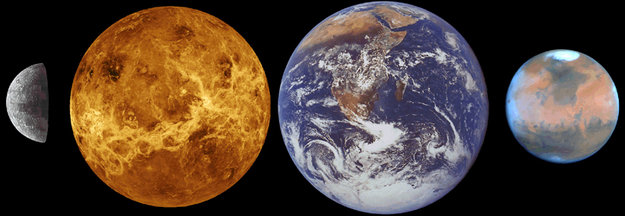Just how Goldilocks is planet Earth?
In the story of Goldilocks things are not too big, not too small, not too hot, not too cold etc. everything is "just right".
In solar systems there appears to be a "goldilocks zone" which is in the "habitable" zone or a zone where life like our own may emerge on a planet because there is an appreciable atmosphere and liquid water on the surface.
This zone exists in a region where a planet is not too close to the sun but also not too far. It's orbit is "just right". Too close to the sun and any water would boil away, too far from the sun and it would all be frozen.
Also it turns out that the size of the planets found within this zone must also be not too big and not too small.
So not only must the planet be in the Goldilocks zone, it must also be a Goldilocks planet.
Our solar system has 3 planets which could qualify as being in the habitable of Goldilocks zone.
Earth
Mars
Venus
Each of these has had an atmosphere and likely surface water at some stage of its planetary evolution. Mars may even have harbored microbial life.

But, Earth of the 3, is the only one that proved to be "just right". It's size was perfect for its distance from the sun and furthermore it has the Moon to stabilize its spin and axial tilt.
Mars was perfect, for a while, but because it is a lot smaller than earth it lost internal heat more rapidly and its molten core froze. Without a molten core it lost its magnetic field generated by flows of metals inside the planet. This left Mars's atmosphere exposed to the abrasive solar wind and gradually its atmosphere was stripped away.
Mars lost most of its water and what little was left is found in two frozen polar ice caps or frozen beneath the surface of the rusted soil. It's this iron oxide(rust) coated soil and dust that gives mars its rust red colour and cause the ancients to name it after their god of war.
Venus likely also had appreciable amounts of water in its atmosphere and on surface but being a little closer to the sun at some time got to hot. This overheating caused water vapor to escape into its upper atmosphere where it too was stripped away by the solar wind.
The water left on Venus now is mostly "heavy water" containing deuterium. This enrichment in deuterium is all that remains after the lighter isotopes of water had been removed at some distant time in the past.
Without enough water to form rain there was nothing to stop the build up of carbon dioxide and other nasties in the atmosphere and besides the air being toxic Venus now has a surface temperature in the region of 400 degrees thanks to the effect of greenhouse gasses etc.
So not only is Earth in just the right zone within the solar system, it is also just the right size for its orbital distance.
Two more "just right's" to add to the so called "fine tuned" universe.
source: @gavvet